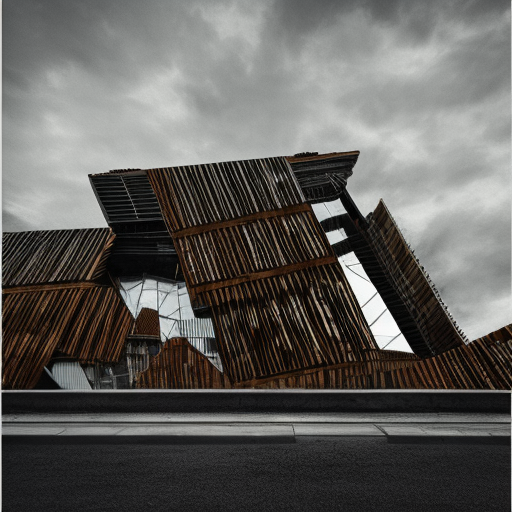Summary:
Deconstructivist architecture is a movement that emerged in the late 1980s, characterized by fragmented forms, distorted geometries, and a sense of disorientation. It challenges traditional notions of architecture and seeks to disrupt the conventional understanding of space and structure. Deconstructivist architects, such as Frank Gehry and Zaha Hadid, use unconventional materials and innovative construction techniques to create buildings that defy expectations and provoke thought.
Origins and Influences:
Deconstructivist architecture emerged as a response to the rigid and predictable designs of modernism. It draws inspiration from various sources, including the theories of philosopher Jacques Derrida and the visual arts movement of deconstruction. Architects like Peter Eisenman and Bernard Tschumi were influenced by Derrida’s ideas of deconstruction, which questioned the stability and fixed meanings of language and text. They applied these concepts to architecture, challenging the traditional understanding of form and function.
Characteristics:
Deconstructivist architecture is characterized by several key features. One of the most prominent is the fragmentation of forms, where buildings appear to be broken apart or composed of multiple intersecting elements. This fragmentation creates a sense of disorientation and challenges the viewer’s perception of space. Distorted geometries are also common, with irregular angles, skewed planes, and asymmetrical compositions. These unconventional forms often result in buildings that appear dynamic and visually striking.
Another characteristic of deconstructivist architecture is the use of unconventional materials and construction techniques. Architects often experiment with materials such as steel, glass, and concrete, pushing their limits to create unique and innovative structures. The construction process itself becomes part of the design, with exposed structural elements and unconventional connections.
Key Architects:
Several architects have made significant contributions to the deconstructivist movement. Frank Gehry is perhaps the most well-known, with iconic buildings like the Guggenheim Museum Bilbao and the Walt Disney Concert Hall. Gehry’s designs often feature fragmented forms and dynamic shapes, creating visually stunning and sculptural buildings.
Zaha Hadid is another influential figure in deconstructivist architecture. Her designs, such as the Heydar Aliyev Center in Baku and the Guangzhou Opera House, are characterized by fluid lines and organic shapes. Hadid’s buildings challenge traditional notions of structure and create spaces that are both functional and visually captivating.
Other notable architects in the deconstructivist movement include Rem Koolhaas, whose works include the CCTV Headquarters in Beijing, and Daniel Libeskind, known for the Jewish Museum Berlin. These architects have pushed the boundaries of architecture, creating buildings that challenge the viewer’s perception and provoke thought.
Impact and Criticism:
Deconstructivist architecture has had a significant impact on the field, inspiring a new generation of architects to think outside the box and challenge established norms. It has also influenced other art forms, such as sculpture and product design, with its emphasis on fragmentation and unconventional forms.
However, deconstructivist architecture has also faced criticism. Some argue that its focus on form over function can lead to impractical and inefficient buildings. Others criticize its lack of contextual sensitivity, as deconstructivist buildings often stand out in their surroundings and may not harmonize with the existing urban fabric.
In conclusion, deconstructivist architecture is a movement that challenges traditional notions of architecture and seeks to disrupt the conventional understanding of space and structure. It is characterized by fragmented forms, distorted geometries, and the use of unconventional materials and construction techniques. Architects like Frank Gehry and Zaha Hadid have made significant contributions to the movement, creating visually striking and thought-provoking buildings. While deconstructivist architecture has had a significant impact on the field, it has also faced criticism for its focus on form over function and lack of contextual sensitivity.












